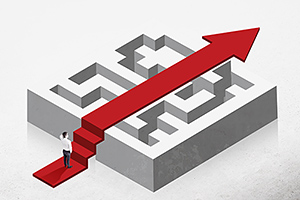The basis for Chinese medicine is embedded in its theory. In fact, the treatment is the diagnosis (e.g., spleen qi deficiency), and the diagnosis is essentially all our fundamental theory strung together to create a pattern.
However, theory is only useful if we don't get bogged down by it, and one can't seem to feel a little confused when they begin the study of the eight extraordinary channels.
Getting Reacquainted
There are many water metaphors in Chinese medicine. For example, per the Nan Jing, "The sages built ditches and reservoirs; when these are full they overflow into deep lakes ... in the human body, when the channels are overfilled, they overflow into the Eight Extraordinary Vessels where they are no longer part of the general circulation." The extraordinary channels not only receive the overflow qi from main channels, but also can circulate qi back if the main channels become deficient.
 Li Shi Zhen has something to say about where this overflow flows and the functions of these channels: "When the Qi of the channel overflows, it flows into the Extraordinary vessels where it is turned into irrigation, warming the organs internally and irrigating the space between skin and muscles externally."
Li Shi Zhen has something to say about where this overflow flows and the functions of these channels: "When the Qi of the channel overflows, it flows into the Extraordinary vessels where it is turned into irrigation, warming the organs internally and irrigating the space between skin and muscles externally."
The eight extraordinary channels also integrate with the six extraordinary yang organs (blood vessels, bones, marrow, gallbladder, uterus and brain), while reaching the six orifices (mind, eyes, ears, nose, mouth, and urethra/anus).
There is much more theory that surrounds the eight extraordinary channels, such as their ability to balance the other channels and areas of the body; that they derive from and hold kidney-essence; and that they control the seven- and eight-year life cycles of women and men, respectively. However, I argue that when it comes to using the channels in clinic, we must shift our focus more toward the areas over which they preside.
Clinical Application
Each extraordinary channel has its own acupoint that opens the channel, as well as a paired point that must be used simultaneously in order to achieve this regulation. Additionally, each channel has its own area that it presides over; however, when used with its pair, it presides over a larger body zone.
LU 7 (Lieque) is used to open Ren, while its pair KD 6 (Zhaohai) is used to open Yinqiao. SI 3 (Houxi) is used to open Du, while UB 62 (Shenmai) opens Yangqiao. PC 6 (Neiguan) opens Yinwei, and SP 4 (Gongsun) opens Chong. TW 5 (Waiguan) opens Yangwei, and GB 41 (Zulinqi) opens Dai.
Together, LU 7 and KD 6 preside over anything along the anterior midline and medial leg. SI 3 and UB 62 cover the posterior midline, scapular region and lateral leg. PC 6 and SP 4 cover the chest and abdomen (both the front and hypochondriac regions), as well as the medial arm. TW 5 and GB 41 preside over the lateral arm, the head (especially lateral) and the beltline area.
The purpose of opening these channels can be found in the Zhen Jiu Ju Ying: "This treatment method is very broad indeed. It is known as setting a very broad net in open country to catch a single rabbit."
When we first learn acupuncture, we are introduced to key or command acupoints LI 4 (Hegu), LU 7, ST 36 (Zusanli), and UB 40 (Weizhong). We are taught that if we are working in an area, we can augment our treatment by using one of these command points; the same can be said for the confluent pairs and the respective zones they treat.
If a patient is exhibiting symptoms such as red eyes, a runny nose, sore throat, upset stomach and perhaps even a weak bladder, opening up the Ren channel by way of its LU 7 and KD 6 pair is an effective way to "cast a wide net," treat an entire zone and augment the efficacy of a treatment.
SI 3 and UB 62 could be used for a patient whose chief concerns include occipital headache, tightness in the trapezius and lower back pain. PC 6 and SP 4 are often used for any menstrual or digestive concern because of the area they cover. TW 5 and GB 41 could be used for a temporal headache and a pulling sensation in the inguinal ligament.
There could be one symptom present or many – the key is having the ability to group symptoms together by location in order to use a confluent pair.
There are practitioners of old who are known for their specialty; who've created a mini-system. Sometimes we have to do the same: respecting the tradition while looking for the strict clinical application. When done in this manner, our chosen theory becomes inseparable from the wanted outcome: improving the patient's quality of life.
Author's Note: For more in-depth usage on the eight extraordinary channels, I highly recommend The Channels of Acupuncture: Clinical Use of the Secondary Channels and Eight Extraordinary Vessels, by Giovanni Maciocia.
Click here for more information about Kenton Sefcik, RAc, Dipl. Ac., Dipl. TCM.




